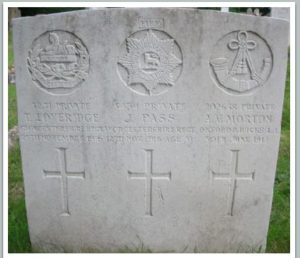1st Battalion, Gloucestershire Regiment

Thomas Loveridge was born in 1868 at St Peter’s, Cheltenham and he declared his age as 44, when he attested for military service on 17 October 1914.
He stated that his occupation was a Hawker although the 1901 Census also shows him as a Mender of umbrellas and that he had previous military service with the Gloucestershire Militia (but was now disembodied).
His Army Pension Record papers have survived and these give some details of his military service. His first posting was to the 8th Battalion, Gloucestershire Regiment before he moved to France with the 2nd Battalion on 12 March 1915 (confirmed on his Medal Index Card).
On 11 November 1915 he transferred to the 1st Battalion of the Glosters and remained with them, as part of the British Expeditionary Force on the Western Front, until 18 January 1916. His conduct was considered ‘good’, the only blemish the imposition, by the Commander of 27th Infantry Brigade Depot, of 10 days Field Punishment No 1 and the forfeit of 14 days pay as a result of being ‘absent off fatigue when duly warned’.
On 19 January 1916 he was back in England at the Depot of the 3rd Battalion of the Glosters, where he remained until discharged from the Army on 21 May 1916. The reason for the discharge appears to have been severe arthritis.
A medical board convened on 28 April 1916 noted Private Loveridge’s assertion that whilst he had suffered a little rheumatism for years. This had never been as bad as when he was in France in 1915. His knees, ankles, elbows and fingers were now stiff and painful at times and he also suffered attacks of asthma.
The board concluded that his condition was not a result of his Army service but aggravated by it. He was awarded a small pension, reviewable in November 1916.
Thomas Loveridge returned to his home at Cumberland House, Grove Street, Cheltenham, where he lived with his wife Adelaide (née Butler), whom he had married in Cheltenham on 25 April 1900. The couple had three children, born in 1902, 1907 and 1909 respectively.
He died of unspecified causes in Cheltenham General Hospital on 25 November 1916, aged 48 and was buried in Cheltenham Cemetery. He is commemorated on the Cheltenham Town War Memorial.
Curiously, Private Loveridge is buried in a multiple CWGC plot, along with two other soldiers (5434 Private J Pass, Worcestershire Regiment who died 12 November 1916: 202638 Private A V Morton, Oxfordshire and Buckinghamshire Light Infantry, who died 30 June 1917).
The other soldiers probably died whilst serving in the area and were buried in the plot one before and one after Private Loveridge. Double burials were quite common but three graves to one plot is usually only found in attlefield cemeteries and even then rarely.
Over the plot the CWGC has erected what may possibly be a unique headstone, three stones merged into one, bearing separate details of each soldier.*
A photograph of Private Loveridge’s funeral appears in The Graphic of 9 December 1916. After the war his widow was living at 4 Cow Lane, Swindon.
* Evidently this type of headstone is not unique but it is very unusual and the extended headstone performs a similar function to a screen wall commemoration where there are multiple burials in a plot (common in cemeteries which were linked to military hospitals).
